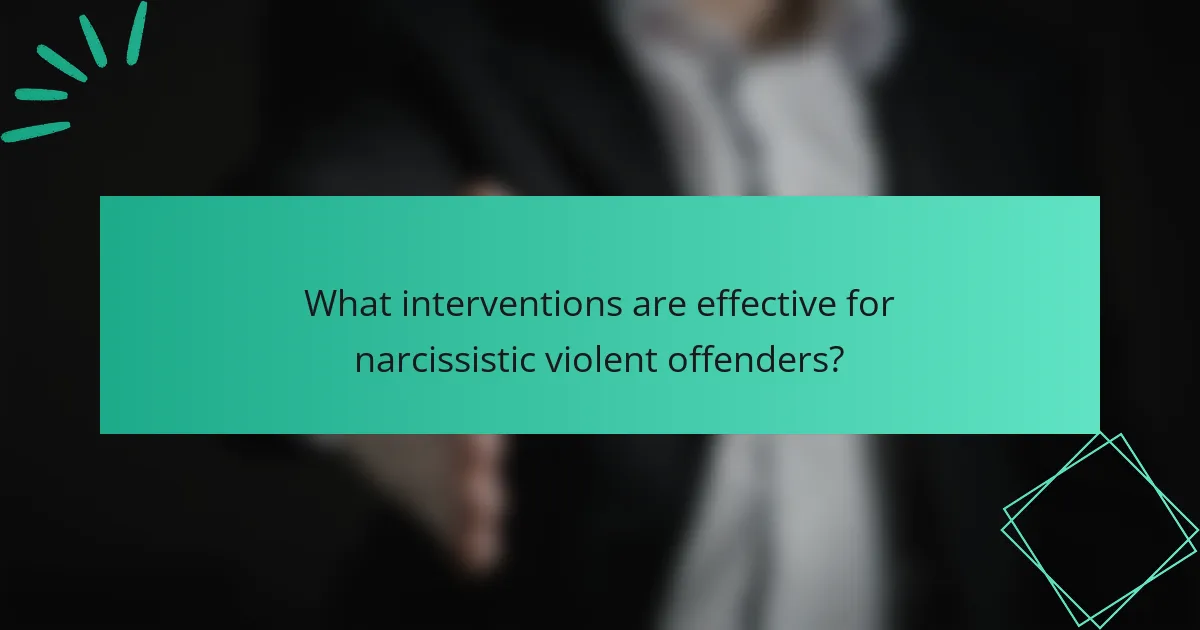Narcissism plays a crucial role in the behavior of violent offenders, often manifesting as a sense of entitlement and a profound lack of empathy. Individuals with narcissistic traits may resort to aggression when their self-image is threatened or their demands are unmet, viewing others merely as tools for their own gratification. This psychological profile is particularly prevalent among violent offenders, with studies indicating a significant correlation between narcissistic traits and violent behavior.

How does narcissism contribute to violent behavior in offenders?
Narcissism can significantly contribute to violent behavior in offenders by fostering a sense of entitlement and a lack of empathy. Individuals with narcissistic traits may react aggressively when they perceive threats to their self-image or when their demands are not met.
Narcissistic traits linked to aggression
Common narcissistic traits associated with aggression include grandiosity, entitlement, and a strong need for admiration. These traits can lead to a heightened sensitivity to criticism, resulting in defensive or violent reactions. Offenders may display a pattern of blaming others for their failures, which can escalate to aggressive behavior.
Additionally, narcissists often lack empathy, making it easier for them to justify harmful actions against others. This combination of traits creates a volatile environment where perceived slights can trigger disproportionate responses.
Case studies of violent offenders
Several case studies illustrate the link between narcissism and violent behavior. For instance, high-profile criminals often exhibit narcissistic traits, such as a need for control and a disregard for the well-being of others. These offenders may commit violent acts to assert dominance or to retaliate against perceived threats.
One notable example is that of a convicted serial offender who displayed classic narcissistic behaviors, including manipulation and a lack of remorse. Such cases highlight the potential for narcissism to manifest in extreme violence when combined with other risk factors, such as substance abuse or a history of trauma.
Psychological mechanisms involved
The psychological mechanisms linking narcissism to violence often involve cognitive distortions and emotional dysregulation. Narcissists may interpret neutral or ambiguous situations as personal attacks, prompting aggressive responses. This misinterpretation can lead to a cycle of violence, where the offender feels justified in their actions.
Furthermore, narcissists often struggle with emotional regulation, making it difficult for them to manage anger or frustration. This inability to cope with negative emotions can result in explosive outbursts, particularly when their self-esteem is threatened.

What are the characteristics of narcissistic offenders?
Narcissistic offenders typically exhibit a range of distinctive traits, including a lack of empathy, a sense of entitlement, and a tendency to manipulate others. These characteristics often contribute to their violent behaviors, as they may view others as mere tools for their own gratification.
Common personality traits
Narcissistic offenders often display grandiosity, believing they are superior to others and deserving of special treatment. This inflated self-image can lead to an inability to accept criticism and a strong reaction to perceived slights.
Additionally, they may exhibit a profound lack of empathy, making it difficult for them to understand or care about the feelings of others. This emotional detachment can facilitate violent actions, as they may not fully grasp the consequences of their behavior on their victims.
Behavioral patterns in violence
Narcissistic offenders often engage in violent behavior as a means of asserting dominance or control. They may resort to aggression when their self-image is threatened or when they feel disrespected, viewing violence as a way to re-establish their perceived superiority.
Moreover, their manipulative tendencies can lead to premeditated acts of violence, where they plan their actions to achieve specific outcomes. This calculated approach can make their violent behaviors particularly dangerous, as they may carefully select their targets and methods to maximize impact.

How prevalent is narcissism among violent offenders in the UK?
Narcissism is notably prevalent among violent offenders in the UK, with studies indicating that a significant portion of these individuals exhibit narcissistic traits. These traits often manifest as a lack of empathy, a need for admiration, and a tendency toward manipulative behavior, which can contribute to violent actions.
Statistics on narcissism in violent crime
Research suggests that narcissistic personality traits are found in around 20-30% of violent offenders in the UK. This prevalence is higher than in the general population, where narcissism is estimated to affect about 1% of individuals. The correlation between narcissism and violent crime highlights the need for targeted interventions in criminal psychology.
Additionally, studies have shown that violent offenders with narcissistic traits often have a history of antisocial behavior, which can further complicate their psychological profiles. Understanding these statistics can aid in developing effective rehabilitation programs.
Comparative analysis with other personality disorders
When comparing narcissism to other personality disorders, such as antisocial and borderline personality disorders, it becomes clear that each has distinct characteristics influencing violent behavior. Antisocial personality disorder, for instance, is more strongly associated with impulsivity and a disregard for societal norms, while narcissism is linked to grandiosity and a need for validation.
In terms of prevalence, antisocial personality disorder is found in approximately 3% of the general population, making it more common than narcissism. However, the combination of narcissistic traits with antisocial behavior can lead to particularly dangerous outcomes in violent offenders. Understanding these differences is crucial for law enforcement and mental health professionals in assessing risks and tailoring interventions.

What interventions are effective for narcissistic violent offenders?
Effective interventions for narcissistic violent offenders include cognitive-behavioral therapy and group therapy, which focus on altering maladaptive thought patterns and enhancing social skills. These approaches aim to reduce violent tendencies and improve interpersonal relationships.
Cognitive-behavioral therapy approaches
Cognitive-behavioral therapy (CBT) is a structured, goal-oriented treatment that helps individuals recognize and change distorted thinking patterns. For narcissistic violent offenders, CBT can address issues such as entitlement and lack of empathy, which often contribute to violent behavior.
Therapists may use techniques like cognitive restructuring to challenge harmful beliefs and role-playing to practice empathy. Regular sessions, typically once a week for several months, can lead to significant improvements in behavior and emotional regulation.
Group therapy effectiveness
Group therapy provides a supportive environment where narcissistic violent offenders can interact with peers facing similar challenges. This setting fosters accountability and encourages the development of social skills, which are often lacking in these individuals.
Effective group therapy sessions often include discussions about personal experiences, guided feedback, and structured activities that promote empathy. The shared experiences can help participants realize the impact of their actions on others, leading to meaningful behavioral changes.

How can understanding narcissism inform prevention strategies?
Understanding narcissism can significantly enhance prevention strategies for violent behavior by identifying at-risk individuals and implementing targeted interventions. By recognizing the traits associated with narcissism, communities can develop proactive measures that address underlying issues before they escalate into violence.
Community awareness programs
Community awareness programs play a crucial role in informing the public about the signs and risks associated with narcissism. These programs can include workshops, seminars, and informational campaigns that educate individuals on recognizing narcissistic behavior and its potential link to violence.
Effective community initiatives often involve collaboration with local organizations, schools, and mental health professionals. For example, a community might host a series of events that focus on emotional intelligence and healthy relationship skills, helping to foster an environment that discourages narcissistic tendencies.
Early intervention strategies
Early intervention strategies are essential for addressing narcissistic traits before they lead to violent outcomes. These strategies can involve counseling and support services tailored to individuals displaying narcissistic behaviors, particularly during formative years.
Schools and community centers can implement programs that focus on social-emotional learning, teaching skills such as empathy and conflict resolution. Additionally, parents and guardians should be encouraged to engage in open dialogues with children about emotions and interpersonal relationships, helping to mitigate the development of harmful narcissistic traits.

What role does environment play in narcissism and violence?
The environment significantly influences the development of narcissistic traits and violent behaviors. Factors such as family dynamics, social interactions, and community context can either exacerbate or mitigate these tendencies in individuals.
Impact of childhood experiences
Childhood experiences are crucial in shaping narcissism and potential violent behavior. Adverse experiences, such as neglect or abuse, can lead to a fragile self-esteem that may manifest as narcissism in adulthood. Conversely, supportive environments that foster empathy and emotional regulation can reduce the likelihood of developing violent tendencies.
For example, children who receive consistent validation and healthy boundaries are less likely to exhibit narcissistic traits. In contrast, those who grow up in chaotic or abusive settings may develop a distorted self-image, leading to aggression and entitlement.
Socioeconomic factors influencing behavior
Socioeconomic status plays a significant role in the prevalence of narcissism and violence. Individuals from lower socioeconomic backgrounds may experience heightened stress and fewer resources, which can contribute to aggressive behaviors and narcissistic traits as coping mechanisms. Economic instability can exacerbate feelings of inadequacy and entitlement.
Moreover, access to education and mental health resources can vary widely based on socioeconomic status. Those with limited access may not receive the support needed to address narcissistic tendencies or violent impulses, perpetuating a cycle of behavior. Communities with higher socioeconomic stability often provide better opportunities for emotional development and conflict resolution, reducing the likelihood of violence.

How does narcissism compare to other factors in violent crime?
Narcissism plays a significant role in violent crime, often interacting with other psychological factors. While it can contribute to aggressive behavior, it is essential to consider how it compares to traits like psychopathy and the influence of substance abuse.
Comparison with psychopathy
Narcissism and psychopathy share some overlapping traits, such as a lack of empathy and manipulative behavior, but they differ in critical ways. Narcissists often seek admiration and validation, while psychopaths typically exhibit a more pervasive emotional detachment and a calculated approach to their actions.
In violent offenders, psychopathy is often linked to more severe and persistent criminal behavior compared to narcissism. For instance, while a narcissistic individual may act violently to protect their self-image, a psychopath may do so without any emotional investment, viewing others merely as tools or obstacles.
Influence of substance abuse
Substance abuse can exacerbate the effects of narcissism in violent offenders, leading to increased impulsivity and aggression. Narcissists under the influence of drugs or alcohol may act out violently as their inhibitions lower, making them more prone to aggressive outbursts.
Moreover, the combination of narcissism and substance abuse can create a cycle of violence, where the individual’s inflated self-image leads to risky behaviors and violent encounters. Understanding this interplay is crucial for developing effective intervention strategies for those at risk of violent behavior.

What are the emerging trends in research on narcissism and violence?
Recent research indicates a growing link between narcissism and violent behavior, particularly among certain offender populations. Studies suggest that individuals with high levels of narcissistic traits may be more prone to aggression and violent acts, often as a response to perceived threats to their self-image.
New psychological studies
Recent psychological studies have begun to explore the nuances of narcissism in relation to violent behavior. Researchers are focusing on how traits such as grandiosity, entitlement, and a lack of empathy can manifest in aggressive actions. These studies often utilize self-report measures and behavioral assessments to gauge the correlation between narcissistic traits and violent tendencies.
One significant finding is that narcissistic individuals may react violently when their self-esteem is threatened. This reaction can be triggered by criticism or perceived slights, leading to aggressive outbursts. Understanding these triggers is crucial for developing interventions aimed at reducing violence among narcissistic offenders.
Moreover, studies are increasingly examining the role of environmental factors, such as childhood experiences and social influences, in the development of narcissistic traits. This holistic approach helps to identify potential prevention strategies that could mitigate violent behavior in at-risk individuals.



